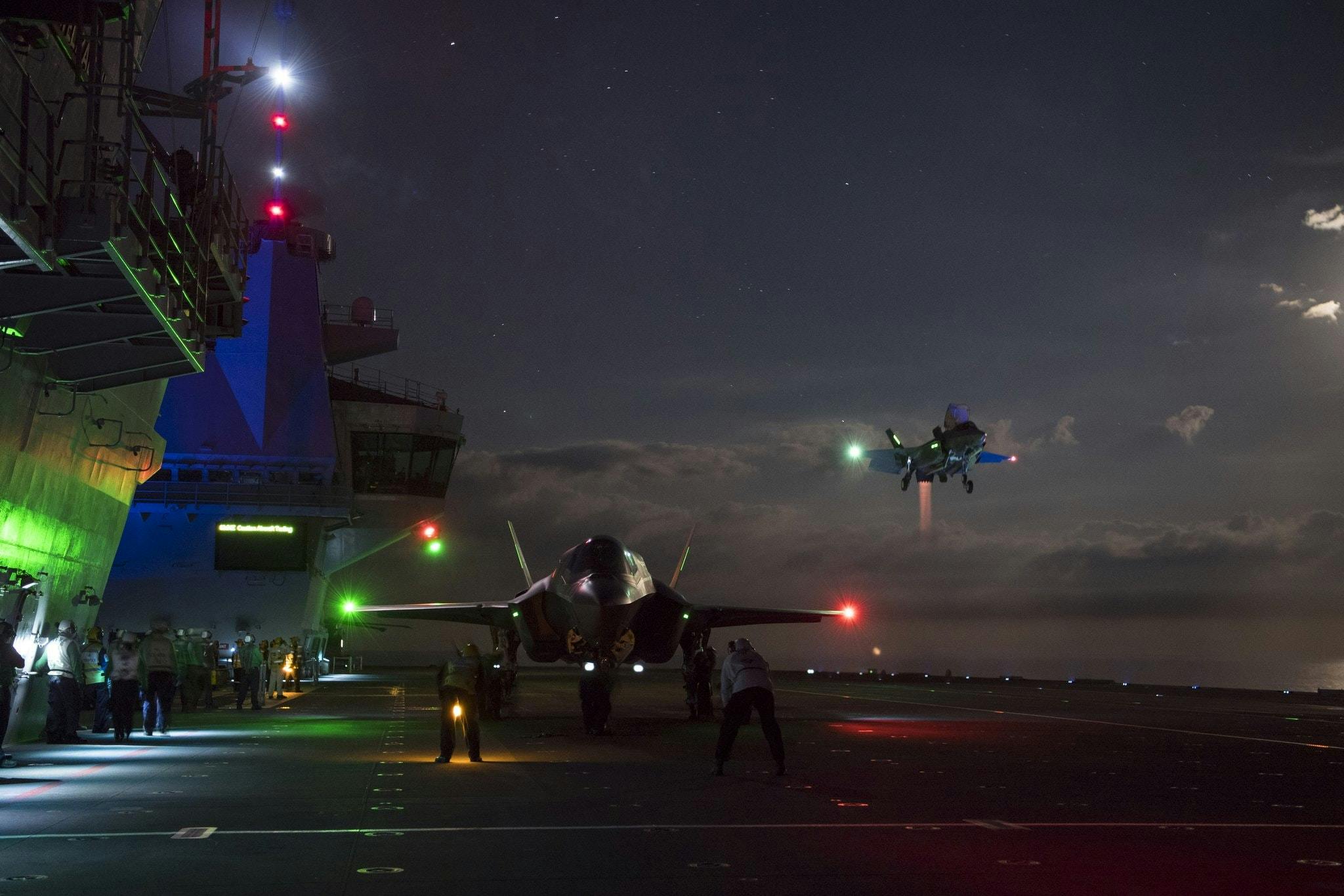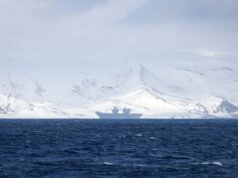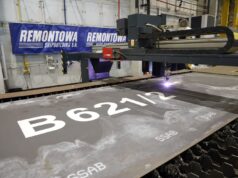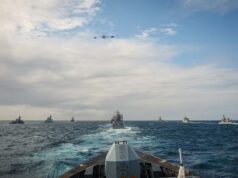Four F-35 Lightning jets have completed the first nighttime carrier landings on HMS Queen Elizabeth in UK waters.
The Ministry of Defence say in a news release that ‘Exercise Lightning Fury’ over the North Sea was aimed at ensuring 207 Squadron achieves essential carrier flying and Landing Signals Officer (LSO) supervisory qualifications.
Of course, the first night landings on the vessel itself occurred during the WESTLANT18 deployment off the US coast, an image from that deployment is below.

HMS Queen Elizabeth recently sailed from her home port of Portsmouth to conduct training with UK F-35 Lightning jets in home waters. Specifically, the ship is sailing to conduct Carrier Qualifications as well as Landing Signal Officer qualifications with 207 Squadron, the UK’s F-35 Lightning training squadron.
Defence Secretary Ben Wallace said:
“Few countries in the world have the capacity and technology to deploy fighter jets from an aircraft carrier in the North Sea. These trials put the UK at the helm of 5th generation warfighting and cement the UK as a Tier 1 military power.”
Commander UK Strike Force, Mike Utley said:
“Operating the UK’s Lightning Force from the deck of HMS Queen Elizabeth in UK waters is a significant milestone, and one we are delighted to have shown the Secretary of State for Defence in person.
This training with 207 Squadron will set the conditions for valuable warfighting exercises later this year between the operational Squadron and the ship. The future utility of these tremendous UK Defence assets is gaining clarity each day as we push the envelope of their combined ability, leading to the first combined operational deployment of the carrier strike capability next year.”
824 Naval Air Squadron personnel have also been honing their night flying & submarine hunting skills on HMS Queen Elizabeth. 824 Naval Air Squadron is based at RNAS Culdrose and is equipped with eight Merlin helicopters.
The Ministry of Defence say that the UK will declare Initial Operating Capability for Carrier Strike by the end of 2020.
The first operational deployment for HMS Queen Elizabeth, 617 Squadron and a squadron of US Marine Corps Lightning jets is due to take place in 2021. The carrier will deploy with two frigates, two destroyers, a nuclear submarine and support vessels.














Since its 207 sqn. the OCTU, these current operations are presumably to qualify F-35 pilots for carrier ops?
Not only for the qualification of more pilots but I suspect the writing and refinement of the flight training manuals and testing the limits of the F35B.
Two questions does anyone know if the QE is operating alone or with some firgates and destroyers, and is there any plan for the QE to meet up with the PoW when she goes of to Liverpool at the end of the month. That would be a good photo op for the media.
Training the trainers. Exciting step forward for our rejuvenated carrier capability.
Are they doing vertical landings (with the slight forward element of matching the ship’s speed) or the SRVL landings? Don’t think I’ve seen any footage of the SRVLs undertaken at sea.
My understanding is that a test pilot has done a rolling landing but more equipment is still needed to perfect it. Again, I believe that this business is not as straight forward as it might look.
Mostly if not all VLs
Was first SRVL was actually covered on UKDJ, UKDJ youtube link below.
https://www.youtube.com/watch?v=2m8Zx7c3IcI
So order some more F-35’s already!! Two squadrons and 48 aircraft is not enough.
Does anybody know if Chris Terrell is onboard filming another documentary?
Apparently he missed WESTLANT19, but may well be on board for the deployment next year. Be interesting to see how the Brits get on with the USMC…
Thanks, I guess he had to sweeten his wife up by spending some time with her before the Pacific deployment if he indeed going. I for one would definitely like to see him cover it.
More like I wonder how the USMC will handle a wet ship, all in all I think the USMCAF will get on just fine with the RN mode of operation just as long as there leathernecks and our bootnecks don’t get into a bar together.
I do wonder though would the USMC have to toast to ‘the Queen’?
Ron, I suspect that the first toast will be to the Queen, and the second to the President of the US. What will be more interesting will be to see if the US marines will toast the Presidents Health sitting down, as we do for the Sovereign.
Sit for the Queen and stand for the President? I don’t see a problem with that as it respects each others traditions, besides I would have thought that would have been sorted already, given the number of times the USMC have exercised on RN ships.
Come on Chariot Rider it was a bit tounge in cheek, just thinking about it how would you toast the President of the US on a US ship, they are dry. Just think of the fun that could be had with the Royal Navy toast of the day especially the old ones and don’t forget the standing toast, for those that don’t know this one it’s as follows
“The wind that blows, the ship that goes And the lass that loved a sailor”
God, by the time they have carried out all of the toasts, to The Queen, with the USMC on board the President, toast of the day, the standing toast, the Immortal Memory, I also think that there are a few extra for special occasions, they would need to be carried away.
All good fun, hope that they work hard, enjoy themselves and that everything is smooth sailing.
DOH! Missed that one. 🙂
Why would anyone stand for Trump? Other than an idiot that is!
Will the USMC be bringing their own maintainers?
My understanding is that the US Navy at least does aircraft maintenance very differently to pretty much anyone else and I would guess that the Marines would use the same approach.
Unless things have changed, and I am going back some years now, the USN used to have highly specialised fitters. The best example to explain what I mean is that the USN used to train fitters to maintain and repair the front undercarriage of a particular aircraft type and then another one to do the same job to the left main gear and more to do the right main gear. The UK trains undercarriage specialists so have to be able to work on any part of the aircrafts’ undercarriage. That’s how it was explained to me at the time, so might not be the case now to be fair.
The UK approach makes for smaller crews and if a plane takes serious damage potentially more time to fix things, whilst the US approach could speed turn around times but makes for big crews…
Yes, they will bring there own maintainers, as our crews will not be cleared to work on their aircraft. It may be just a paperwork legality exercise as the aircraft are exactly the same.
We usually only have a couple of guys do the before and after flight maintenance. Which involves checking levels, looking for damage and downloading the aircraft’s health data. If faults are found then more people get involved from either the mechanical or avionics trades.
I think that the RN and USMC maintainers will learn alot from each other. Out of interest who maintains the aircraft on the QE, RN/FAA/or RAF, or if its Apaches/Chinooks would the Army Air Corp send their maintainers, or would it depend on which squadrons are on board. I really don’t know.
Interesting question Ron. I think that with the Joint Lightening force or Joint Helicopter force it will depend on who is available / cleared to deploy regardless of cap badge. I think the UK forces are too small to get too hung up on cap badges.
RN staff officers / specialists were deployed to Afghanistan, so where needs must I think.
The issue is something diffrent, I remember reading about RAF types on RN Carriers, 1937-1942, it did not work well. it starts with officer ranks, a RN Lt is a Capt in the Army or Fl.Lt in the RAF. At sea the RN ranks is one more then ashore so a Lt RN is a Sq Leader in the RAF or a Major in the Army. So it comes down to the line of command. So basically what happens when a RN Lt give an order to a Capt Army Air Corp?
Not only that but the RAF and the Army Air Corp are used to working on base with workshops and a supply line the RN/FAA have a make do and mend mentality. The FAA would put an aircraft in the air when the RAF would ground it. A perfect example would be the use in Korea, aircraft on the carriers suffered from wrinkling in the airframe, following RAF procedures they were unairworthy, the FAA did some fixies and back in action. The RAF would refuse to fly such plane, the FAA pilots took them into action and shot down MIGS.
See the diffrence in mentality and operation needs.
So it comes back to the question, who fixes the planes and whirlybirds and what is the command system.
Yeh, differences in conops and service practice could be an issue but I think it should be pretty much sorted by now given experience with the Joint Harrier Force.
The history of the Fleet Air Arm is mixed as it was the Fleet Air Arm of the Royal Air Force until 1939. Senior RAF officers were putting much of their money into bombers in the 20’s and early 30’s, with Dowding managing to get the Hurricane, Spitfire and Home Chain network into service just in time. All of which meant the Fleet Air Arm started WW2 with some of the best Carriers around at the time and outdated aircraft. Sad, but it gave us a legend in the Swordfish..!
My understanding is that the difficulties were at the senior / interservice level whilst on board everyone was literally in the same boat so got on with it! Can’t be many left to tell how it really was now, so we can only read about it…
Speaking of the Harrier, what are the chances that one will ever land on a QE-class ship?
Initially with the F35 there will be a mix of FAA/RAF personnel for maintaining the aircraft, as it takes time to qualify enough engineers on type. Once the Sqns have enough manpower, then they will deploy as a complete Sqn and take all their personnel. I’ve yet to hear if they do the big wing of maintainers like they did with Harrier? It doesn’t work and is crap for morale. For the Chinook and Apache they’ll take their own respective personnel i.e. RAF and AAC/REME.
The RNand USMC have a long history of working together. We had a USMC Harrier sqn onboard HMS Illustrious back in 2007 for around a month with 14 jets. Great bunch of guys.
I asked this question a few years ago on the FB QEZ page a few years ago. It seemed odd to me that a crab tech who has basically signed up to work in a comfyish airfield hangar wksp would be expected to deploy on a carrier for x number of months. Or is this now standard procedure/terms of service after Joint Force Harrier? (Btw absolutely no disrespect to RAF but as ex-REME i would be suprised if i had had to deploy in any other way than on the ground with my squadron/company/wksp.)
Hi Big H. I totally get what you mean, but today everyone in the forces has to be very flexible, and we have alot more joint operations, RAF now go to sea, RN ratings have worked in Afghanistan ect. I won’t always say it was popular, but that is the way of the world now.
RB- Thats fine with me, im all for streamlining and getting the most out of our overstretched forces (poor lads, i joined when all the tv ads were of Frank skiing down the mountains and an NI tour was the biggest test of your mettle). So RAF tech Smith either chooses Typhoon (guaranteed cushy workshop, Generally uk etc) or F35 (probable Carrier deployment)? I suppose they know the score and have the choice.
What weapons will be fitted during their first deployment will they be different between ours & usmc. If they are different how will the automatic weapons loading cope. These are just some of the questions that need to be addressed. I can see potential for a lot of issues arising with another countries fighter aircraft along side ours. Not being integrated fully.
And think the professional’s in the RN and USMC will have thought about that.
With the Block 3 and soon to be block 4 software upgrades. All F35s will have the capability of using whatever weapons have been cleared on the aircraft. So technically the USMC F35Bs could been fitted with ASRAAM and Meteor. However, the pilots would not be qualified or have any experience of its use. Both Meteor and ASRAAM are cleared for being launched up to the max airspeed and g rating, so realistically they still could point and shoot, if they’ve read the notes on its parameters. This will be the same for us, AMRAAM is currently the long range AAM cleared on the Block 3s and we don’t use AIM-9X Sidewinders. So our crews will have experience of using it. It will be interesting to see each others views on Small Diameter Bomb and Spear 3. It will be a really interesting tour.